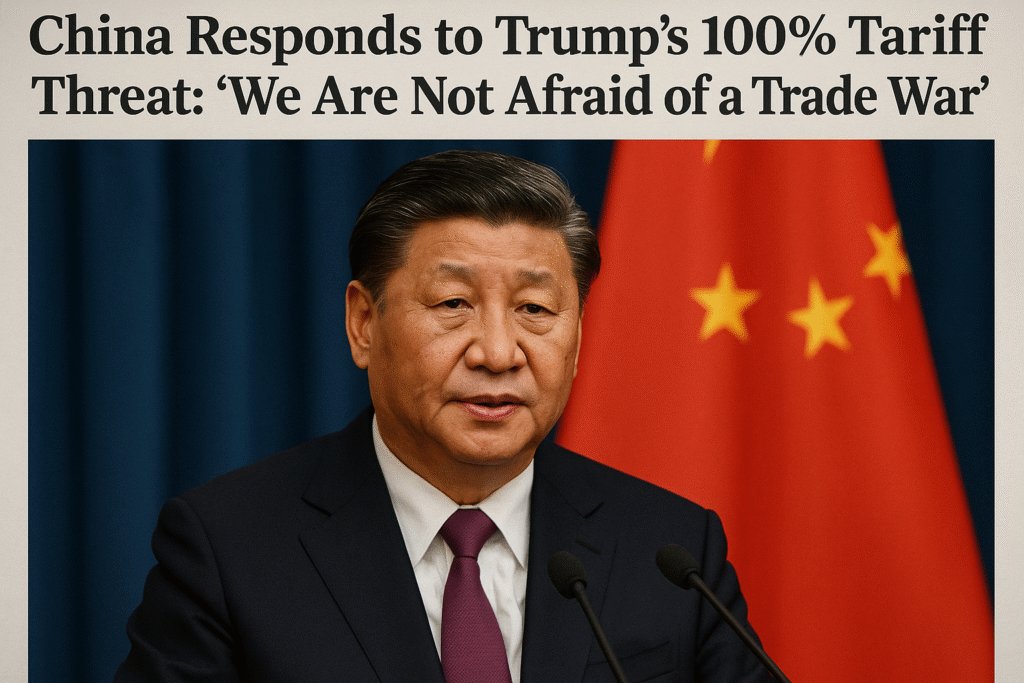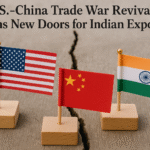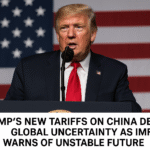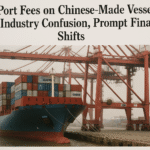By Harshit Washington, D.C., October 12, 2025 – 8:30 AM EDT
China has issued a strong response to U.S. President Donald Trump’s latest escalation in the ongoing trade conflict, declaring that it “is not afraid of” a trade war. The statement came after Trump vowed to impose an additional 100% tariff on Chinese imports in retaliation for Beijing’s new export controls on rare earth minerals — critical materials used in electronics, defense systems, and clean energy technologies.
China Accuses U.S. of “Double Standards”
In a statement released Sunday, a spokesperson for China’s Ministry of Commerce accused the U.S. of hypocrisy, saying Washington has long “overstretched the concept of national security” and abused export control measures against Chinese firms.
“The United States has taken discriminatory actions and imposed unilateral long-arm jurisdiction on semiconductor equipment, chips, and other products,” the spokesperson said. “China does not want a trade war, but we are not afraid of it.”
The ministry added that Trump’s threats to double tariffs were a “textbook double standard,” noting that the U.S. Commerce Control List covers more than 3,000 items — over three times the number of items on China’s export list.
Markets React to Tariff Threats
Trump’s announcement on Truth Social late Friday sent shockwaves through global financial markets. U.S. stocks plunged, wiping out nearly $2 trillion in equity value in a single trading day. Economists warned that an all-out trade confrontation between the world’s two largest economies could destabilize global supply chains and further drive inflation.
Trump said the new tariffs, which will take effect on November 1, are intended to counter what he called Beijing’s “economic coercion” and efforts to “hold the world captive” through its dominance in rare earth production.
Rare Earths at the Center of the Dispute
China currently controls about 70% of global rare earth supply — materials essential for manufacturing electric vehicles, wind turbines, smartphones, and advanced military equipment. Beijing’s new export restrictions require foreign entities to apply for licenses to export products containing more than 0.1% Chinese-sourced rare earths or made using Chinese technology. Exports with potential military applications will be automatically denied.
The Ministry of Commerce defended the new rules as “legitimate” under international law, saying they aim to “safeguard world peace and regional stability.” It stressed that the restrictions are not outright bans, and applications meeting requirements will still be approved.
However, the European Chamber of Commerce in China reported a backlog of export license applications, warning that the measures could complicate global supply chains for rare earth elements.
Escalation Extends to Shipping and Trade Talks
Tensions escalated further when Beijing announced it would begin charging docking fees for U.S. ships at Chinese ports starting October 14 — a direct response to similar U.S. fees set to take effect the same day. China’s Commerce Ministry described the move as a “necessary passive defensive action.”
This tit-for-tat escalation threatens to derail recent diplomatic progress. Senior officials from both nations met multiple times this year — in Geneva, London, and Stockholm — to negotiate a trade framework. The most recent meeting in Madrid in September reportedly produced a “basic consensus” on the divestment of TikTok’s U.S. operations.
Trump and Chinese President Xi Jinping had also agreed to meet later this month during the Asia-Pacific Economic Cooperation (APEC) summit in South Korea. However, Trump threatened on Friday to cancel the meeting following Beijing’s latest rare earth restrictions.
Outlook: A Deepening Divide
Analysts say the current standoff underscores how fragile U.S.–China relations have become. “What began as a trade dispute has evolved into a full-scale geopolitical and technological rivalry,” said Dr. Mei Lin, a senior fellow at the Asia Policy Institute. “Both sides are weaponizing trade tools to assert dominance in critical industries like semiconductors, AI, and defense.”
For now, the world watches closely as Washington and Beijing exchange economic blows. With both economies intertwined and global markets on edge, the next few weeks could determine whether diplomacy prevails — or if the world’s two largest economies spiral into another round of destabilizing trade warfare.







